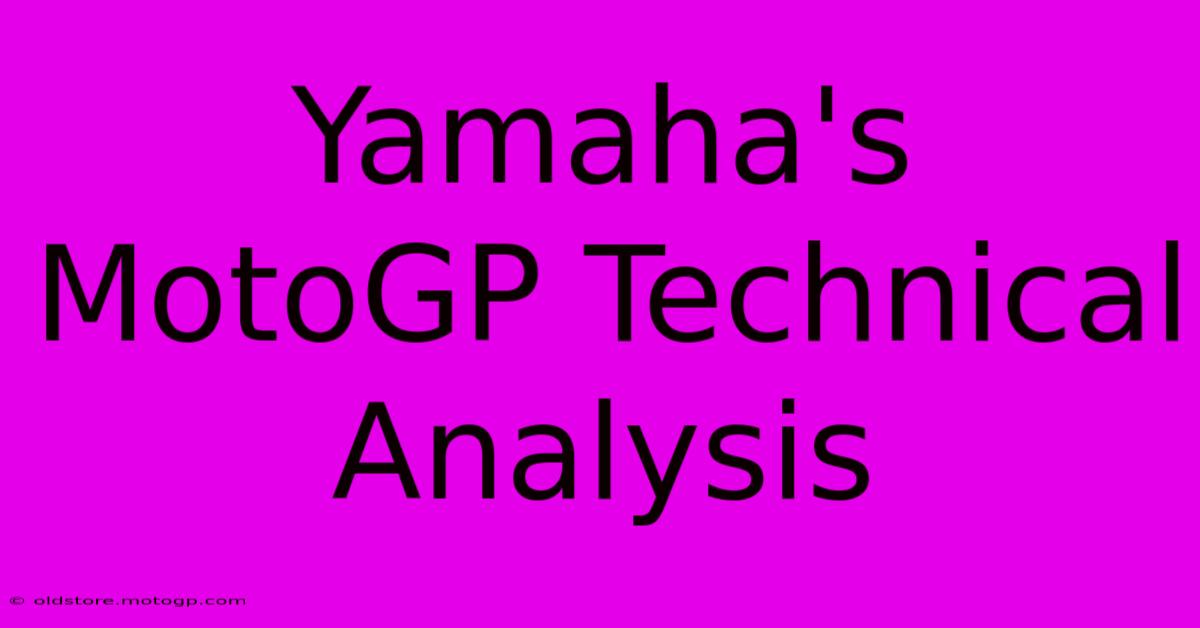Yamaha's MotoGP Technical Analysis

Table of Contents
Yamaha's MotoGP Technical Analysis: Unpacking the 2023 Season and Beyond
Yamaha's performance in MotoGP has been a rollercoaster in recent years. While historically a dominant force, the team has faced significant challenges, particularly in adapting to the current generation of bikes and tires. This article delves into a technical analysis of Yamaha's MotoGP efforts, exploring their strengths, weaknesses, and potential areas for improvement.
Yamaha's Strengths: A Legacy of Innovation
Yamaha boasts a rich history in Grand Prix racing, building a reputation for innovative engineering and meticulous attention to detail. This legacy continues to underpin their current MotoGP project. Specifically:
- Engine Performance: Yamaha's inline-four engine is renowned for its smooth power delivery and high-revving capabilities. While perhaps not the outright most powerful on the grid, its character contributes to exceptional corner exit acceleration and agility.
- Chassis Design: Yamaha's chassis, while often criticized for its lack of outright stability, offers impressive agility and feedback to the rider. This allows for precise control, especially in tight corners and changing track conditions.
- Electronics Package: Yamaha's electronics package, though less publicly discussed than some competitors, is sophisticated and effectively integrated with the chassis and engine. It contributes significantly to overall rideability and performance consistency.
Yamaha's Weaknesses: Areas Requiring Attention
Despite their strengths, Yamaha has faced significant challenges in recent seasons, many stemming from the following areas:
- Top Speed Deficit: A persistent weakness for Yamaha is their lack of top speed compared to rivals like Ducati and Aprilia. This deficit is most pronounced on long straights and significantly impacts race results, especially on circuits with extensive fast sections.
- Tire Management: Yamaha has struggled with tire degradation, particularly in hot conditions. This limitation often restricts race strategies and necessitates more conservative riding styles, potentially impacting overall race pace.
- Adaptability to New Regulations: Yamaha has arguably been slower than some competitors to adapt to the evolving technical regulations and tire compounds introduced in recent years. This has led to a perceived gap in performance and competitiveness.
The 2023 Season: A Case Study
The 2023 MotoGP season provides a perfect case study for analyzing Yamaha's current situation. While [insert specific rider results and performance highlights here, referencing specific races and tracks], the team clearly faced ongoing challenges. Analyzing the team's performance across different tracks—those favoring top speed versus those emphasizing cornering—will reveal the extent of these weaknesses and point towards critical areas of improvement.
Potential Solutions and Future Directions
To regain competitiveness, Yamaha needs to address its key weaknesses:
- Aerodynamic Improvements: Significant investments in aerodynamic development are crucial to reducing the top-speed deficit. This could involve exploring different winglet designs, fairings, and chassis modifications to optimize airflow and reduce drag.
- Engine Development (Balancing Power and Reliability): While maintaining the engine's characteristic smooth power delivery, Yamaha needs to explore avenues to improve outright power without compromising reliability.
- Tire Management Strategies: Close collaboration between engineers and riders is vital in developing strategies and setup configurations that optimize tire life and performance. This may involve developing new tire compounds in collaboration with tire manufacturers.
- Data Analysis and Simulation: Enhanced data analysis capabilities and sophisticated simulation techniques can help Yamaha identify and address weaknesses in their current package more effectively.
Conclusion: A Path to Redemption
Yamaha's current situation in MotoGP is undeniably challenging. However, their legacy of innovation and engineering prowess, combined with a focused approach to addressing their weaknesses, suggests a path to redemption. Continued investment in aerodynamic development, engine refinements, tire management strategies, and data-driven decision making are vital for Yamaha to return to the forefront of MotoGP competition. The upcoming seasons will be crucial in observing how effectively they implement these changes and reclaim their position as a top contender.

Thank you for visiting our website wich cover about Yamaha's MotoGP Technical Analysis. We hope the information provided has been useful to you. Feel free to contact us if you have any questions or need further assistance. See you next time and dont miss to bookmark.
Featured Posts
-
Explore Columbus Without A Car Cota One Day Pass
Feb 19, 2025
-
Drive Cota Open Track Day Excitement
Feb 19, 2025
-
The Thrill Of Victory Sting F1
Feb 19, 2025
-
The Science Behind The Speed Tnt Moto Gp
Feb 19, 2025
-
Moto Gp Photoshoot A Moment In Time
Feb 19, 2025
